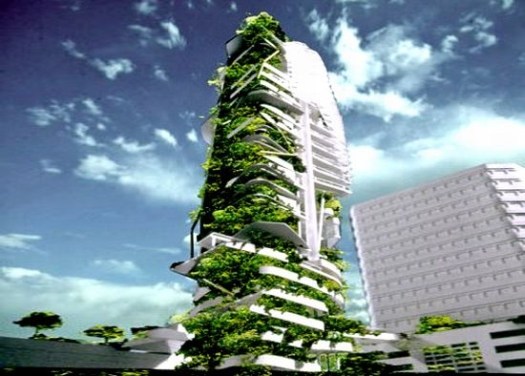
by Natalie Knops
An emerging trend in agriculture, vertical farming, has been developing across the United States. Vertical farms, a new form of green urban architecture, are controlled, indoor environments that regulate lighting, nutrients and weather. These farms are typically set up in hydroponic towers that often inhabit urban buildings (Frazier, 2017). Many are optimistic about the benefits of this practice: fast production, minimization of land use, water conservation, minimization of fertilizer/agricultural run-off, and most significantly – the drastic reduction of transport emissions. Although the concept of vertical farming is increasing in popularity, some are skeptical about the drawbacks of this method due to the fact that retro-fitting buildings for indoor plant cultivation is capital-intensive and energy costs run high. Vertical farming requires specialized LED lights that generate photosynthesis. For many, the concept of running an entire farm off of massive amounts of artificial light energy is a significant disadvantage. Stan Cox, a major opponent of vertical farming, asserts that there are big losses of energy and heavy infrastructure costs that make vertical farming “about as wasteful as a system that it could be (Cox, 2016).” However, lighting has been one of the highest efficiency gains in the last decade; indicating that future lighting systems might be substantially less demanding of energy and therefore less wasteful of a system (Specht, 2013). LEDs have a flexible pulsating ability provides sufficient photon fluxes of specific wavelengths, even when they are turned on and off rapidly. LED has been recently studied in regards to its role as an efficient energy source for indoor plant cultivation was examined. Pulsating LED light treatments have been used to separate light reactions from dark reactions in the process of photosynthesis and photosynthetic electron transport. This pulsation did not affect plant production, and lead to additional savings in energy. LEDs also allow for unnecessary spectrum segments to be removed from the light, thus saving energy while providing the adequate light for photosynthesis to take place (Chung, 2009). Energy saving LED technology is monumental in making vertical farming both economically feasible and sustainable.
Cox, S. (2016, Feb 17). Enough with the vertical farming fantasies: There are still too many unanswered questions about the trendy practice. Retrieved from Salon: http://www.salon.com/2016/02/17/enough_with_the_vertical_farming_partner/
Frazier, I. (2017, Jan 9). The Vertical Farm. The New Yorker.
Specht, K. (2013, May 25). Urban agriculture of the future: an overview of sustainability aspects of food production in and on buildings. Agriculture and Human Values, 31(1), 33-51.
Yeh, N., & Chung, J. P. (2009). High-brightness LEDs—Energy efficient lighting sources and their potential in indoor plant cultivation. Renewable and Sustainable Energy Reviews, 13(8), 2175-2180.
Share this:





